Chapter EIGHT
Portfolio of Edwin Forbes
Zoom in or use your browser’s magnifier to see greater detail of drawings.
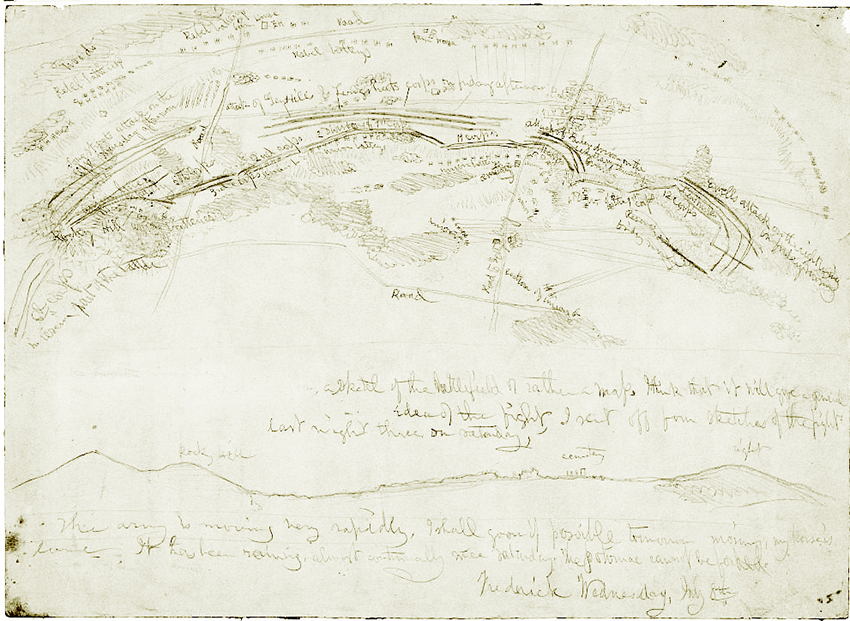
Edwin Forbes map of Gettysburg battlefield (Above) & Elevation of Cemetery Ridge (Below)
Forbes sent this amazingly accurate reconstruction of the Union and Confederate alignments during the 2nd and 3rd days fighting to his editor just a few days after the battle.
Consisting of both a map (at top) with an elevation view (below), it’s almost certainly the first ever documentation of the battleground. His notations on the original are extremely difficult to decipher which prompted me to provide a simplified version with typed descriptions.
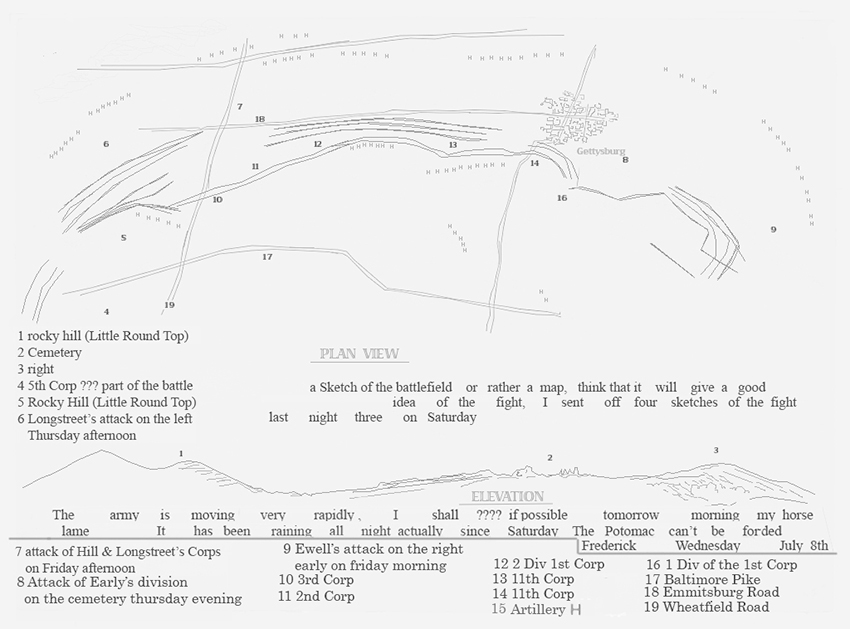

Rebel Battery shells bursting Rebel battery Rebel Battery Peach Orchard
Infantry supporting a battery lying down gettysburg 3rd Corps 2nd July 1863
Forbes’ fanciful illustration shows a 3rd Corp Battery, supported by infantry (lying down), firing on Rebel troops advancing across The Wheatfield midday on July 2nd . Numeral “3” indicates the Trostle barn, Numeral “2” The Peach Orchard. The several batteries Sickles had posted along the Wheatfield Road had no infantry support which is what forced their hasty withdrawal when Longstreet’s infantry reached their positions. As no other batteries are shown, this must have been Bigelow’s 9th. Mass Battery (B).
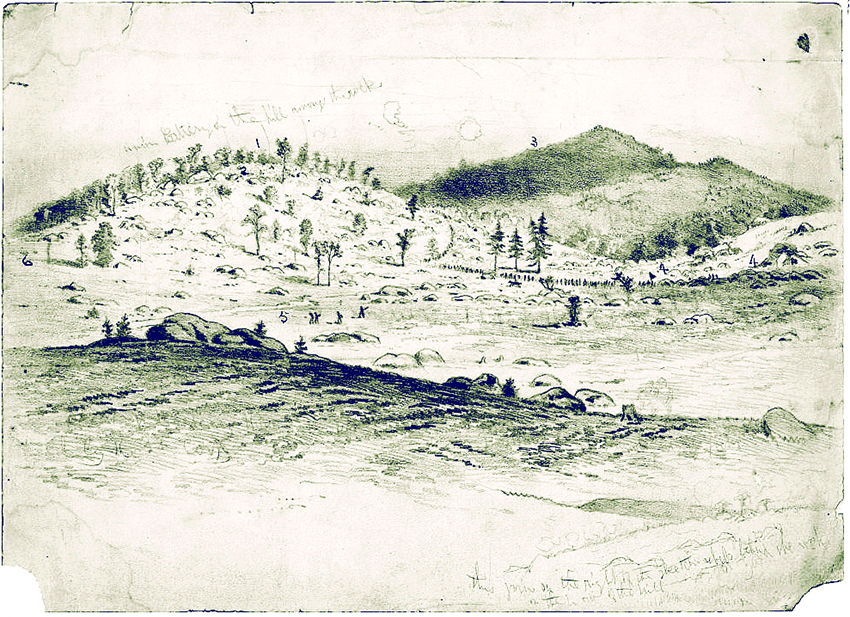
Top: Union battery on the hill among the rocks
Below: This [//] on the right of the sketch rebels behind rock on top of the hill
View is of Little Round Top’s western face with the valley of Plum Run and Devils Den situated at its base. Presumably Rebel troops in the valley below are being shelled by a Union battery located near the crest. The extreme southern shoulder of this mount was the initial point of attack of Longstreet’s Corp, Hood’s Division on Thursday afternoon, July 2nd. As with so many of Forbes contributions, the view is at so great a distance no action can be observed.

rebel battery crest of the hill rebel batteries in fields rebel battery in the [?] fields
infantry dark brick cemetery [?] hill
limbers and caissons behind guns Road to Gettysburg
This is easily the most intriguing drawing Forbes produced at Gettysburg. Labeled “July 2nd/63 6:30pm,” it’s an aerial view of the Evergreen Cemetery gatehouse and surrounding landscape shortly before Rebel forces overran two Union batteries posted on the eastern crest of Cemetery Hill. The point-of-view he adopted suggests that Forbes worked from an elevated position which, for several reasons, could not have been the case. Why he went to the extraordinary length of creating an imaginary aerial perspective depicting a completely static scene is mystifying! However, this fake POV has the affect of making this his most interesting (though wildly inaccurate) drawing.
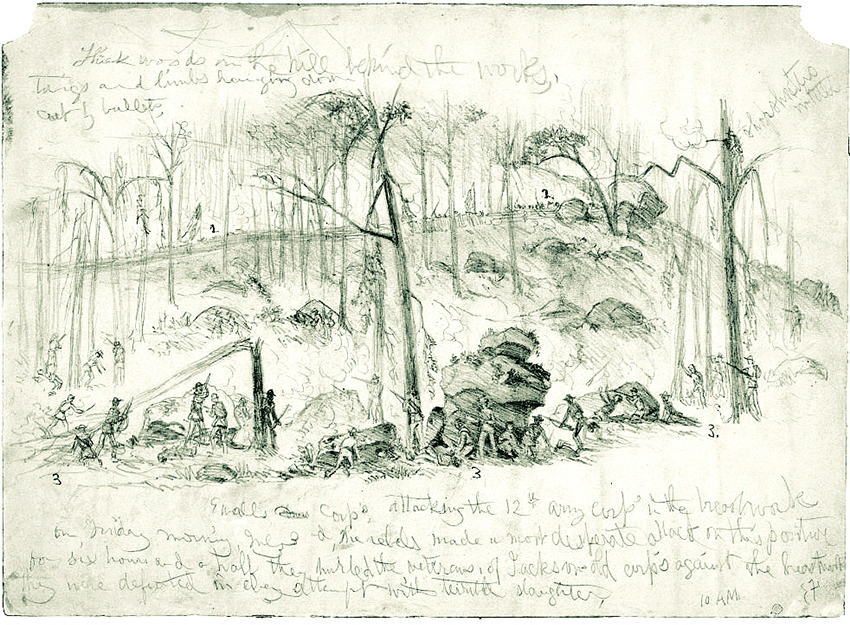
Top left: Thick woods on the hill behind the works Trees and limbs hanging cut by bullets
Top Right: Sharpshooters [?]
Below: Ewell’s Corp attacking 12th Army Corp in the breastwork on Friday morning July 3rd, the rebels made a most desperate attack on the position for six hours and a half they hurled the veterans of Jackson’s old corps against the breastwork they were defeated in their attempt with terrible slaughter
Forbes made this drawing of the Rebel assault on Culp’s Hill after the Confederate withdrawal on July 4th. He captures the distance the assaulting force had to cover in the ascent, but fails to convey the steepness and brokenness of the wooded terrain confronting them. His rendering implies the Rebels worked their way up darting from cover to cover, but their assaults were carried out (as best they could be) employing the standard rank and file formations.
An exceptional piece of fantasy is his inclusion of the “sharpshooter” high atop a tree. One has to question how he could have shinnied up so far. Loading and firing his weapon would have been just as impossible as his climb! Had he, by some miraculous means, managed to accomplish this, it would surely have spelled his doom, as the recoil from his Enfield rifle would have blown him right off his roost!
“Stonewall” Jackson had been killed at Chancellorsville the month before necessitating a restructuring of the Army of Northern Virginia. Longstreet maintained command of the 1st Corp with Richard Ewell assuming command of what had been Jackson’s 2nd Corps. Ambrose Powell Hill was given command of the newly formed 3rd Corp composed of units reassigned from both the 1st and 2nd Corps.
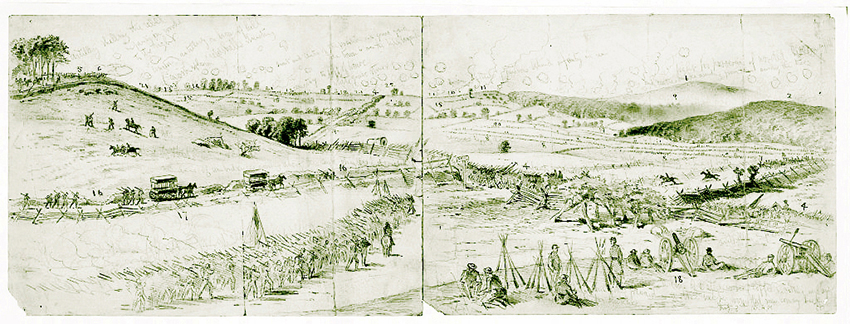
A battle had been raging on the Union right flank on both Culp’s and Cemetery Hills since 4:30 in the morning of July 3rd when (at 10a.m.) Forbes all but ignored this fight in favor of creating a panorama showing what was taking place in the intervening two miles. One has to wonder why Forbes felt this behind-the-scene activity would be deemed of any great importance by his editor? It seems impossible, but Forbes produced a postwar oil based on this sketch that is even less instructive! (See Appendix B.)

Sketch of the fight on Thursday evening and Friday afternoon from the Rocky Hill on the left of Gen Meade’s position. Rock Hill [Little Round Top] in foreground. Union battery in position shelling the enemy. This position was held by 5th Corp
Once Forbes’ extensive written note is ignored, this image is almost reduced in half, and only a third of what remains contains even a minimal amount of detail. The remainder is little more than a landscape of distant fields and more distant mountains. “Pickett’s Charge” is underway in the fields below Little Round Top, but Forbes only includes a bare hint of this in his rendering.
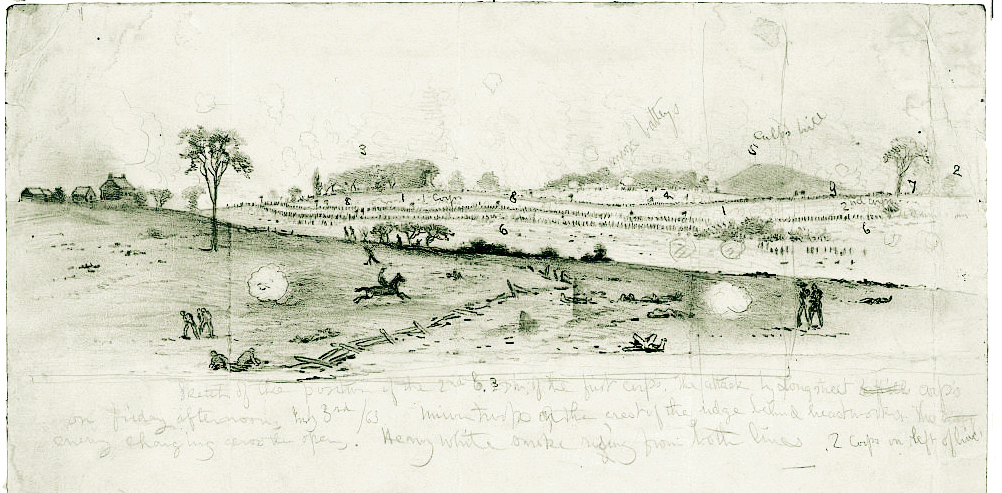
Sketch of the position of the 2nd Div of the first corps. the attack by Longstreet Corps on Friday afternoon, July 3rd/63 Union troops of the crest of the ridge behind breastworks the enemy charging [??] the open. Heavy white smoke rising from both lines. 2 Corps on left of line.
This is still another example of Forbes’ failure to capture any of the drama of the fighting going on. Perhaps his rendering of a panoramic landscape devoid of meaningful detail was an unconscious admission that he’d chosen to remain far behind the lines rather than witness the maelstrom of “Pickett’s Charge.” His complete failure to picture anything of importance pertaining to this climatic action appears to have completely escaped his awareness, as he worked up his poorly-conceived sketch into a postwar oil painting. (See Appendix B)
Forbes seemed to be under the mistaken impression that providing the engraver with an abundance of call outs (numbered written descriptions ) could somehow make up for his failure to provide any compelling visual content.

The chasm standing between Waud’s and Forbes’ illustration skills becomes obvious when their respective depictions of Rebel captives wearily hiking off to prison camp are compared. Forbes’ composition is pedestrian, completely lacking in drama, and he appears to have lost interest in the prisoners after the first rank. Clearly, he spent more time laying in the supply wagons and farm houses in the background.
Note in lower right corner reads “July 3rd 5 PM /63” meaning Forbes must have drawn this shortly after “Pickett’s Charge” was repulsed. His well-advertised aversion to going anywhere near the fighting worked in his favor on this occasion, as he was located well behind the lines as this column passed by at dusk.

4th of July Behind the breastworks on the right Gettysburg, Pa
Victorious Union soldiers taking it easy on the nation’s birthday. Typical of the sort of “camp life” scenes that Forbes busied himself with, it displays no evidence of the life and death struggle that was waged here just hours before. The only hint that there’d been fighting is the shred of a pennant fluttering from the staff at the center of the tranquil scene.
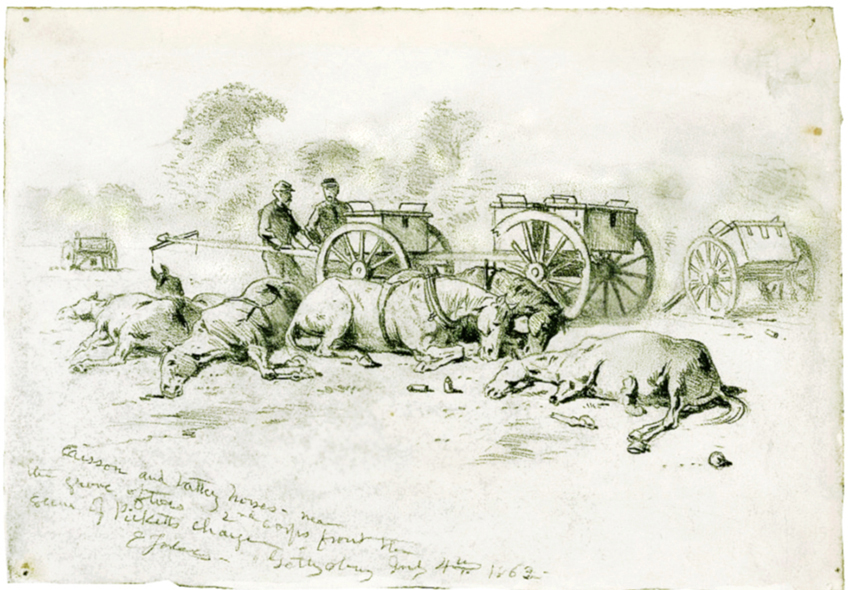
caisson and battery horses – near the grove of trees 2nd corps front the scene of Picketts charge
Gettysburg July 4th 1963 E. Forbes
Easily Forbes’ most compelling Gettysburg drawing. His sympathy for the “Innocent Victims” is manifest in this melancholy tribute to their unwilling sacrifice. Though the dead of both armies were given burials, the horses were simply gathered in huge piles and burned. The swarms of flies that gathered before this gruesome task was completed were remarked on by all those who were compelled to remain in Gettysburg after the battle.
NOTE: Unless otherwise indicated, all illustrations and photography reproduced in this book are from the Library of Congress, Prints and Photos Division, or Manuscripts Division.